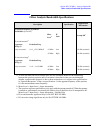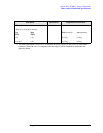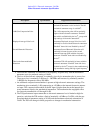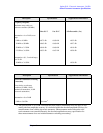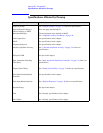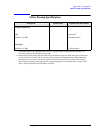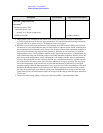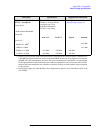
88 Chapter 3
Option EA3 - Electronic Attenuator, 3.6 GHz
Other Electronic Attenuator Specifications
Description Specifications Supplemental Information
Distortions and Noise When using the electronic attenuator, the
mechanical attenuator is also in-circuit. The full
mechanical attenuator range is available
a
.
a. The electronic attenuator is calibrated for its frequency response only with the mechanical
attenuator set to its preferred setting of 10 dB.
1 dB Gain Compression Point The 1 dB compression point will be nominally
higher with the electronic attenuator “Enabled”
than with it not Enabled by the loss
b
, except with
high settings of electronic attenuation
c
.
b. The loss of the electronic attenuator is nominally given by its attenuation plus its excess loss.
That excess loss is nominally 2 dB from 0 − 500 MHz and increases by nominally another
1 dB/GHz for frequencies above 500 MHz.
c. An additional compression mechanism is present at high electronic attenuator settings. The
mechanism gives nominally 1 dB compression at +20 dBm at the internal electronic attenua-
tor input. The compression threshold at the RF input is higher than that at the internal elec-
tronic attenuator input by the mechanical attenuation. The mechanism has negligible effect
for electronic attenuations of 0 through 14 dB.
Displayed Average Noise Level Instrument Displayed Average Noise Level will
nominally be worse with the electronic attenuator
“Enabled” than with it not Enabled by the loss
b
.
Second Harmonic Distortion Instrument Second Harmonic Distortion will
nominally be better in terms of the second
harmonic intercept (SHI) with the electronic
attenuator “Enabled” than with it not Enabled by
the loss
b
.
Third-order Intermodulation
Distortion
Instrument TOI will nominally be better with the
electronic attenuator “Enabled” than with it not
Enabled by the loss
b
except for the combination of
high attenuation setting and high signal frequency
d
d. The TOI performance improvement due to electronic attenuator loss is limited at high fre-
quencies, such that the TOI reaches a limit of nominally +45 dBm at 3.6 GHz, with the pre-
ferred mechanical attenuator setting of 10 dB, and the maximum electronic attenuation of
24 dB. The TOI will change in direct proportion to changes in mechanical attenuation.




